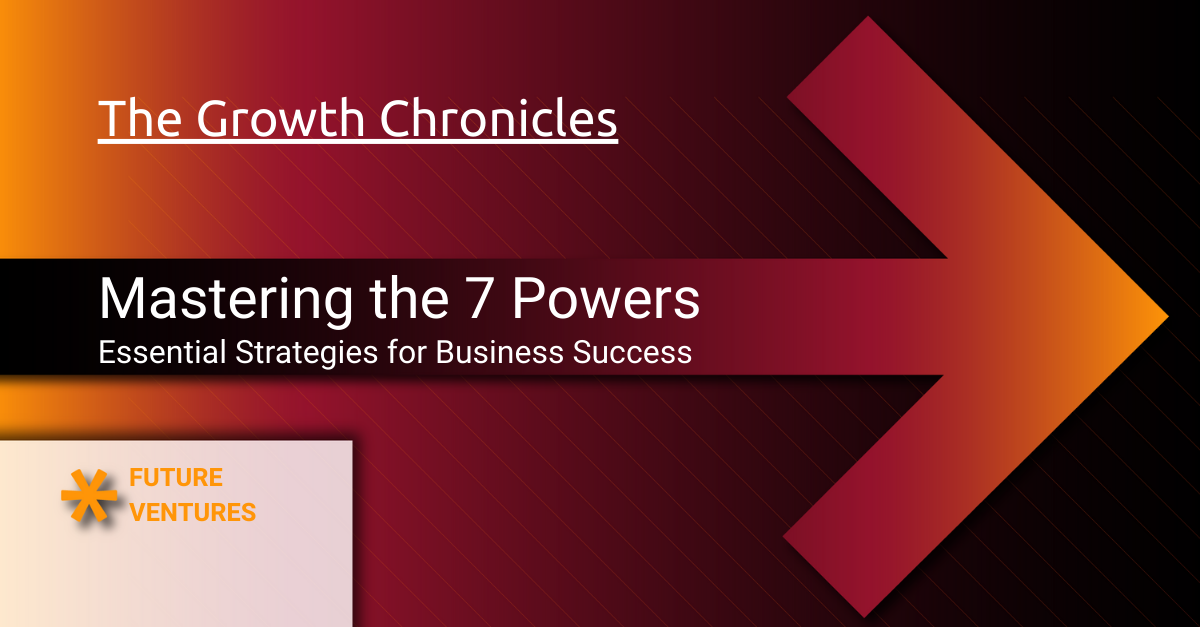Maximizing Growth through Strategic Investments: The Essential Guide
A Practical & Provocative Guide for Founders, CEOs, and Business Owners
Introduction: Why Strategic Investment Is Your Oxygen Mask
If you’re scaling a company, cash flow keeps the lights on, but strategic investment determines whether you build a rocket ship or a rowboat. Too many founders confuse raising money with raising value. You don’t need just capital. You need smart capital, deployed with intention, in line with your long-term growth arc.
Corporations around the world rely on strategic investments to drive growth, maintain stability, and achieve a competitive advantage. Making the right strategic investments is critical to a company's long-term survival and success.
Keeping strategic investments at the forefront of your priorities is essential for sustained growth.
Think of investment like oxygen on a plane: you can survive a little turbulence without champagne service, but when the cabin depressurizes, only oxygen saves you. Designed not just to keep you alive, but to keep you climbing while your competitors gasp for air.
Strategic Investments: The Engine of Corporate Growth
Strategic investments are not optional. They are the lifeblood of corporate growth. For businesses aiming to achieve growth and diversification, strategic investments are essential. These investments support innovation and long-term objectives, making it crucial to allocate resources effectively to maximize their impact.
- Strengthen Market Presence: Acquiring a competitor or an adjacent player accelerates market capture and enhances a company's competitive position.
- Expand Geographical Footprint: Partnering or acquiring abroad is faster than hiring armies of local reps.
- Talent as an Investment: Acqui-hiring is often the most cost-effective way to acquire world-class skills.
- Technology & IP: Owning tomorrow’s patents today is a defensive moat and an offensive weapon, with investments spanning across multiple industries.
- Mergers and Acquisitions: Acquiring another business provides access to customers, products, or technology, enabling rapid growth and competitive advantage, and can enhance a company's capabilities and market reach.
Matrix: Growth Levers of Strategic Investment
| Lever | Short-Term Impact | Long-Term Impact | Risk Level | Example |
|---|---|---|---|---|
| Market Presence | Revenue boost | Brand dominance | Medium | Facebook acquiring Instagram |
| Geographic Reach | Faster entry | Regional scale | High | Starbucks in China |
| Talent Acquisition | Operational lift | Cultural shift | Medium | Google buying DeepMind |
| Technology/IP | Product edge | Monopoly power, with expected synergies and outcomes from strategic investments, potentially impacting long-term cash flows if expected results are not achieved | High | Nvidia in AI chips |
👉 Takeaway: If you’re not investing strategically, you’re not scaling—you’re just treading water.
Attracting Strategic Investors: Courtship, Not Cold Calls
Strategic investors are not just wallets with legs; they are partners in innovation, credibility, and access. These investments typically involve a deeper, ongoing relationship between the investor and the target company, fostering long-term collaboration and mutual growth.
Strategic investors often seek an interest or ownership stake that allows them to influence company decisions, making the level of ownership a key factor in attracting their involvement. The importance of partnership and collaboration is central to attracting strategic investors, as these relationships extend beyond capital to encompass shared goals and innovation.
Corporate Venture Capital (CVC) is typically a department or separate subsidiary of a large operating company, designed to align investments with the parent company’s strategic goals. CVCs tend not to invest at the seed stage but rather at a later round, focusing on more mature opportunities that align with their strategic objectives.
To attract them, you must signal three things:
- Vision: A clear picture of where you’re headed.
- Return Potential: Not just financial upside, but strategic leverage.
- Track Record: Proof you execute when others only pontificate.
It is also wise to discuss your plans with experienced advisors or partners to improve your chances of attracting the right investors.
👉 Takeaway: You don’t attract a world-class investor the way you close a Tinder date. Spray-and-pray pitch decks are digital catcalls. Strategic investors want to feel like the only one in the room. They expect a customized courtship.
Practical Tactics
- Build ecosystem credibility: Publish thought leadership. Win industry awards. Leading CVC groups look for founders who demonstrate industry leadership.
- Develop warm connections: Investors invest in founders they know, rather than companies they know. Strategic investors often support founders with more than just funding.
- Pitch future dominance, not present survival: “Here’s how we redefine the category,” not “Here’s how we keep the lights on.”
Making Strategic Investments: Playing Chess, Not Checkers
When you invest, you’re not just writing checks. You’re making moves on a chessboard that spans years. Strategic investments contribute to a company’s long-term growth, competitiveness, and sustainability by enhancing brand value and stability. These investments often build on existing ones, leveraging prior successes to maximize future opportunities.
The successful execution of investment strategies is crucial for realizing value and achieving the intended business outcomes.
Strategic investments can also lead to improved diversification, reducing a company’s risk by spreading exposure across different markets or sectors.
The Role of Corporate Venture Capital (CVC) as a Strategic Investor
Corporate Venture Capital (CVC) plays a pivotal role as a strategic investor by bridging the gap between traditional venture capital and corporate growth objectives. Unlike independent venture capital firms, CVCs operate as a dedicated arm or subsidiary within a larger corporation, investing directly from the parent company’s balance sheet. This unique positioning allows CVCs to align their investment decisions closely with the parent company’s long-term strategic goals, rather than focusing solely on immediate financial returns.
| Aspect | Description |
|---|---|
| Target Stage | CVCs typically target later-stage startups that complement or enhance the parent company’s existing business, technology, or market reach. |
| Strategic Benefits | Gain direct access to cutting-edge innovations and emerging technologies, providing the parent company with a competitive edge in rapidly evolving industries. Enables effective monitoring of industry trends and early disruption identification. |
| Business Development | Foster collaborative partnerships between the parent company and startups, leading to co-development opportunities, joint ventures, or future acquisitions, creating a mutually beneficial ecosystem. |
| Branding & Marketing | Enhance the parent company’s reputation by associating with innovative, high-growth ventures, attracting top talent and opening doors to new markets and customer segments. |
| Challenges | Balancing financial returns with strategic objectives; integrating startup innovations into the parent company’s operations without stifling agility. Requires clear investment theses, strong governance, and close corporate alignment. |
CVC investments accounted for 52.7% of total VC deal value in the U.S. in 2018, highlighting their growing importance in shaping the future of corporate strategy. They participated in 23% of all VC deals in 2018, totalling 2,790 global deals worth $53 billion.
In summary, CVCs serve as vital strategic investors that not only provide funding but also act as catalysts for innovation, growth, and competitive advantage within their parent corporations.
Types of Strategic Investments
Here is a table summarizing the listed and additional types of strategic investments, including their characteristics:
| Investment Type | Control Level | Risk Level | Capital Outlay | Time Horizon | Description | Example |
|---|---|---|---|---|---|---|
| Equity Stakes | Low to Medium | Medium | Low to Medium | 3–5 years | Ownership providing influence without full control; can affect board decisions. | Amazon’s minority stake in Rivian |
| Acquisitions | High | High | High | 5–10 years | Full or majority purchase of a company; offers market dominance but integration challenges. | Microsoft buying LinkedIn |
| Joint Ventures | Shared | Medium | Medium | 3–7 years | Partnership sharing control, risk, and rewards; requires agreements on management and exit. | Sony & Ericsson phones |
| Technology Bets | None upfront | High | Low to Medium | 7–10 years | High-risk investments in emerging tech with potential asymmetric returns. | Tesla investing in AI chips |
| Joint Arrangements | Shared | Medium | Medium | Varies | Contractual sharing of control; includes joint operations and joint ventures. | Various IFRS-recognized entities |
| Minority Investments | Low | Low to Medium | Low | 3–5 years | Smaller stakes for financial return and some strategic influence. | Venture capital minority stakes |
| Corporate Venture Capital | Varies | Medium | Medium | 3–7 years | Investments by corporate subsidiaries are targeting strategic alignment with the parent company. | CVC investments in startups |
| Partnerships & Alliances | None or Shared | Low to Medium | Low | Varies | Collaborative agreements without equity exchange, focusing on market access or projects. | Strategic alliances in pharma |
| R&D Collaborations | None or Shared | Medium | Medium | Varies | Joint investment in research and development projects to drive innovation. | Pharmaceutical joint research |
| Mergers | Full control | High | High | Long-term | A combination of two companies into one entity to achieve scale and synergies. | Disney acquiring 21st Century Fox |
This table provides a broader view of strategic investments, highlighting different control levels, risks, capital requirements, and time horizons, enabling businesses to select the most suitable investment type in alignment with their strategic objectives.
Investments are typically recorded in the investment account, with the cost method commonly used for initial measurement and ongoing financial reporting. The value of investments is determined for impairment assessments and financial statements, ensuring that any significant changes in value are properly recognized.
👉 Integration Challenges: Strategic investments often encounter hurdles such as cultural clashes and technological incompatibilities, which necessitate careful management to ensure success.
Risk vs. Reward Table
| Investment Type | Control | Risk | Capital Outlay | Time Horizon | Example |
|---|---|---|---|---|---|
| Minority Equity | Low | Medium | Low-Medium | 3–5 years | Amazon in Rivian |
| Majority/Acquisition | High | High | High | 5–10 years | Microsoft buying LinkedIn |
| Joint Venture | Shared | Medium | Medium | 3–7 years | Sony & Ericsson phones |
| Tech/IP Bets | None upfront | High | Low-Medium | 7–10 years | Tesla in AI chips |
👉 Takeaway: Don’t play checkers with capital. Every move should anticipate five future moves.
Achieving Success through Partnerships
Partnerships are force multipliers. You don’t need to own the entire field to win. Sometimes, controlling the ball is enough. Partnerships enable companies to pool resources, such as capital, human resources, and operational assets, for a greater impact.
- Shared Expertise: Partners bring specialized knowledge.
- New Markets: You can access customers more quickly through strategic alliances.
- Innovation Clusters: Think Silicon Valley. The value is in the ecosystem, not the individual firm.
- Collaborative Investment Partnerships: Strategic investors often possess a deep understanding of the venture capital ecosystem and leverage it to establish strong, mutually beneficial relationships.
These partnerships support innovation and business development by enabling companies to allocate resources efficiently and foster growth. CVCs allow parent companies to monitor industry trends in technology, ensuring they remain competitive and informed. CVCs also provide branding and marketing benefits to their parent companies by partnering with promising startups, enhancing their reputation and market presence. Investments in associates are reported as long-term investments and income from associates must be separately disclosed.
👉 Futurist View: By 2030, expect fluid corporate networks where partnerships form and dissolve as easily as software APIs. Owning everything will look archaic; orchestrating value chains will be the new dominance.
Aligning Investments with Long-Term Goals
Here’s where most founders fail: they chase shiny objects that look impressive in press releases but don’t move the needle on their long-term goals. To achieve these long-term goals, it is crucial to invest strategically, making deliberate and calculated investment choices that align with your overall business strategy. Well-aligned investments contribute to sustainable growth and help ensure your company’s continued success.
Checklist for Alignment
- Does this investment reinforce my core business model?
- Will it still matter in 10 years?
- Does it help me outlast competitors in downturns?
- Can I explain its purpose in a 10-word sentence to my board?
Example
Apple invests billions in chip design. Not for vanity, but because control of core technology ensures it can dictate product cycles and margins for the next decade.
Measuring Success and Future Outlook
You can’t manage what you don’t measure. Strategic investments must be judged against clear KPIs.
Key Metrics
- ROI & Payback Period: Hard numbers.
- Market Share Gain: Did it move the needle?
- Innovation Pipeline: Number of new products or patents.
- Talent Retention: Did the acquisition stay or leave?
Futurist Lens
In the next decade, measuring success will go beyond financial KPIs:
- Sustainability Metrics: ESG alignment will determine access to capital.
- Network Strength: Who your partners are will matter as much as your balance sheet.
- Resilience Index: The Ability to adapt in crises will become the ultimate KPI.
Conclusion: The Futurist Playbook for You
If you take nothing else from this guide, remember:
- Money is cheap, strategy is scarce.
- Strategic investments aren’t about chasing growth. They’re about buying time, talent, and terrain.
- The future belongs to companies that align capital with conviction.
Your competitors will continue to chase the next funding round. You? You’ll be the one turning money into power, and power into market dominance.










